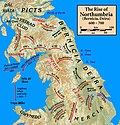Deira
Deira (Brittonic: Dubro or dyfr[a]) was a kingdom in Northern England. The Anglian people living there were known as the Dere. Deira occupied the area that was later called the East Riding of Yorkshire. Deira was one of two early Anglian kingdoms north of the River Humber; the other being Bernicia, their northern neighbor. In the early 7th century they combined to become the kingdom of Northumbria.
Roman and early Anglian Deira
In Roman Britain Deira[b] was separated from Bernicia. The two had a broad area between them where no one lived. The Romans had small defensive works in this area to protect the route to Hadrian's Wall.[3] It was a kind of no man's land after the Angles arrived.[3] Deira first came under the control of the Angles in 560 under their leader Ella.[4] He conquered the Britons in Deira in 581. Deira was still blocked from northward expansion by Bernicia. To the west they were blocked by the last remaining British kingdom of any size, Elmet.[5] King Athelfrith of Bernicia united the kingdoms of Deira and Bernicia into Northumbria.[6] In 617 Edwin of Deira defeated Elmet and expelled their king, Cerdic.[5] Deira and Bernicia were separated again briefly after the death of King Oswald.[3] His brother Oswiu of Northumbria inherited the kingship of Bernicia but did not control Deira until 651. From that time until 867, Deira was treated as a subkingdom of Northumbria. In 867 the Vikings took control of Deira.[7]
Kings of Deira
- Aelle (c. 569–c. 599[8]
- Athelric (c. 599–c. 604[8]
- Athelfrith (604–616) Defeated Deira to form Northumbria[8]
- Edwin (616–c. 633)[8]
- Osric (c. 633–c. 634) Kingdom split back into Deira and Bernicia[8]
- —no ruler— (634–635)[8]
- Oswald (645–642) Reunited Northumbria[8]
- Oswiu of Northumbria (642–670) From 654 he ruled Northumbria.[9] had several sub-kings who ruled Deira:
- Ecgfrith of Northumbria (670–685) Ruled Northumbria.[8] Gave Deira to his brother:[11]
- Elfwine (670–679)[8]
- Aldfrith (685–704) Ruled Northumbria including Deira[8]
Deira Media
Notes
References
- ↑ John Marsden, Northanhymbre Saga; the History of the Anglo-Saxon Kings of Northumbria (London: Kyle Cathie Limited, 1992), p. 27
- ↑ Frank Stenton, Anglo-Saxon England (Oxford: Oxford University Press, 1971), p. 74
- ↑ 3.0 3.1 3.2 Brian Foster, 'The Boundary between Deira and Bernicia', The Modern Language Review, Vol. 51, No. 4 (Oct., 19560, p. 565
- ↑ Thomas Keightley, The history of England, Volume 1, ed. Joshua Toulmin Smith (Boston: Hilliard, Gray, and Co., 1840), P. 10
- ↑ 5.0 5.1 Christopher A. Snyder, The Britons (Malden, MA: Blackwell Publishing, 2003), p. 209
- ↑ Barbara Yorke, Kings and Kingdoms of Early Anglo-Saxon England (London; New York: Routledge, 1990), p. 74
- ↑ Mike Ashley, The Mammoth Book of British Kings and Queens (New york: Carroll & Graf, 1999), p. 272
- ↑ 8.00 8.01 8.02 8.03 8.04 8.05 8.06 8.07 8.08 8.09 8.10 8.11 8.12 8.13 Mike Ashley, The Mammoth Book of British Kings and Queens (New york: Carroll & Graf, 1999), p. 271
- ↑ Peter Hunter Blair, Roman Britain and Early England; 55 B.C.–A.D. 871 (New York; London: W. W. Norton & Company, 1966), p. 196
- ↑ D. P. Kirby, The Earliest English Kings, Revised Edition (London; New York: Routledge, 2000), p. 84
- ↑ D. P. Kirby, The Earliest English Kings, Revised Edition (London; New York: Routledge, 2000), p. 81


